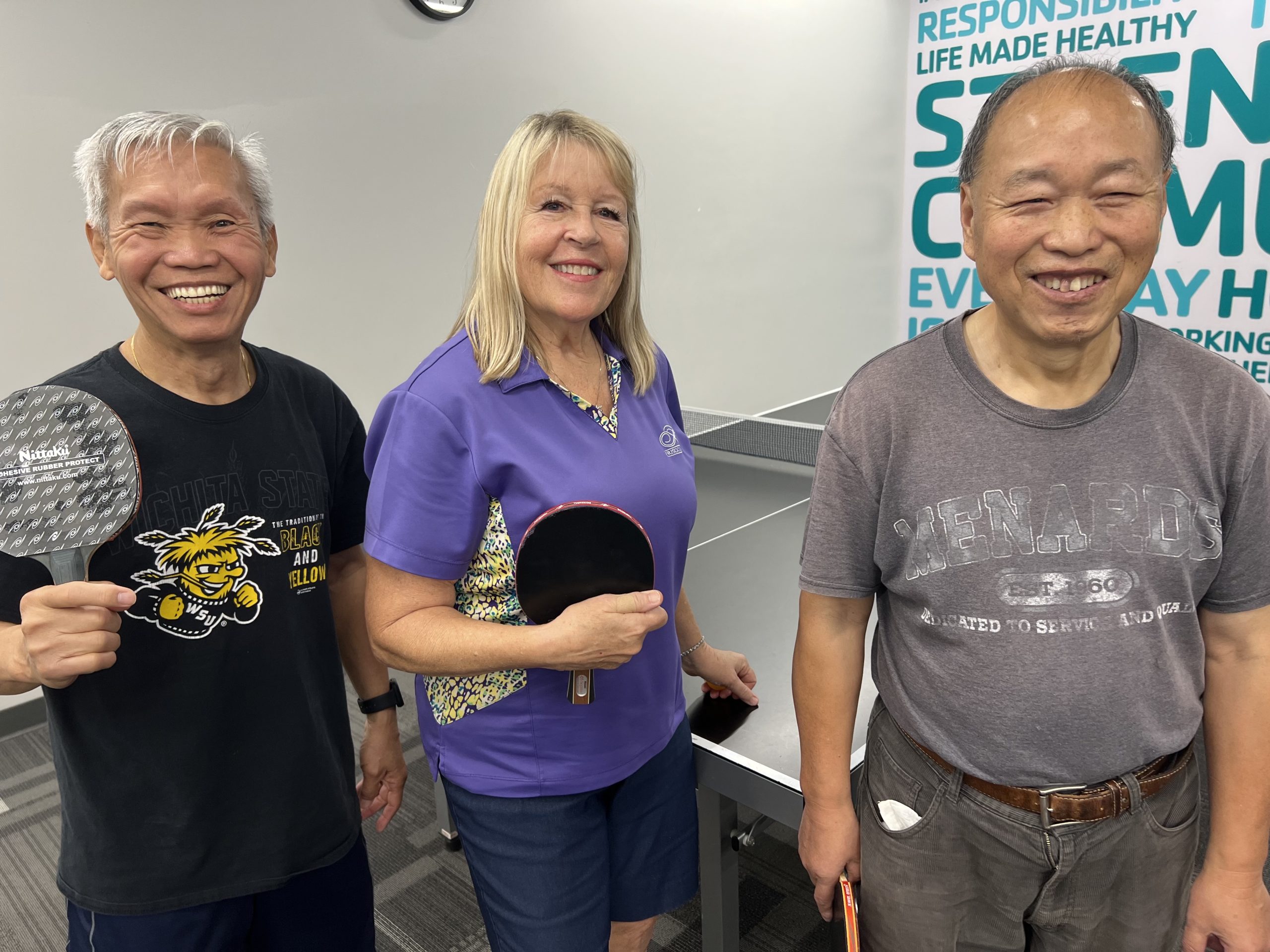If you’re visiting the East YMCA on a weekday between 9:30 and 11:30 a.m., chances are good that you’re going to see three ping pong players —– Debi Takamoto, Quang Ly and Bao Chen — intensely battling just off the lobby where a recreational table is located.
They’ll tell you they’re not that good and that they simply play for fun and exercise. However, retired automobile dealer Dawson Grimsley, who plays after them, says the three are impressive. Grimsley notes that they often play from several feet behind the table like Olympic-level athletes, enabling them to hit and return balls with great velocity and spin.
“It’s unbelievable,” Grimsley said. “I’m like, what the heck?”
Ly played on a team while in school in his native Vietnam but didn’t have anyone to play with after moving to Wichita in 1980.

Quang Ly, far left, grew up playing ping pong in Vietnam, while Bao Chen, far right, did the same in China. Dawson Grimsley, center left, and Debi Takamoto are more recent converts to the sport.
He eventually began playing at the Andover YMCA, which had two ping pong tables before it was struck by a tornado in April.
“Do you know how to play ping pong?” Ly would ask everyone who stopped to watch him play.
Chen, who moved from China to the United States in 1992 and then to Wichita a decade later, was one of those people. He played when he was younger as well.
Takamoto didn’t. She started playing in 2014 when she saw people playing at a rec center in Minnesota. She moved to Wichita two years ago, saw Ly playing and took his invitation to join in.
‘You’re moving’
“It’s supposed to be really good for your health,” Takamoto said. “So that’s, of course, a big plus, but to me it’s fun. And you try to get better, but you just have fun anyway even if you don’t get better.”
“Table tennis and line dancing are, like, two of the best things to prevent Alzheimer’s,” Takamoto added. “You’re watching the speeds, you’re watching the movements. You’re moving.”
Ly has played tennis and pickleball, too, but he said he really works up a sweat in ping pong.
“I like it a lot because that’s a sport that (makes) me healthy,” he said.
Takamoto said ping pong doesn’t pose much threat of injury “if you do it correctly.” Balance and proper footwork when moving from side to side are important. She likened the movement to the way basketball players slide sideways without crossing their feet.
But the sport is accessible to practically anyone, she said, noting that some people are able to stand in one spot and reach most balls.
“I’ve played against people in wheelchairs and people with a cane or whatever.”
Grimsley agreed that “this is really good for you.”
He and YMCA trainer P.J. Barrett used to throw medicine balls during his training sessions. Then he said Barrett teased him that he was elderly “and I needed my hand-eye coordination to be better.”
They started by playing 10 minutes during their hour-long training session. They kept adding time, and now ping pong takes up half of each session.
Grimsley said he absolutely can tell a difference with his dexterity in other things he does now.
“It’s just all the stuff you do all day long.”
Barrett said there’s no question the ping pong training has helped.
“Of course, his ping pong hasn’t gotten better, but his reaction times are better.”
Actually, Grimsley has improved enough to occasionally win.
“I skunked her once, 7-0, and she had a fit,” Grimsley said.
“I did not have a fit,” Barrett said. “I had a very depressing moment.”
Simple fun
If you’ve played ping pong in the past, you may remember that games went to 21 points, with service changes every 5 points. Now, due to a change adopted by the sport’s international ruling body, the game goes to 11 points and service changes every 2 points.
Takamoto said she, Ly and Chen are pretty evenly matched.
“We take turns winning. We take turns losing.”
At Andover, a winner from one game would stay at the table and play the next person while the third person would rotate to the second table. Chen often asked kids to play.
“Bao really likes to help people learn how to play,” Takamoto said.
Ly said it doesn’t matter if someone doesn’t know ping pong.
“We still invite them to come and play with us.”












